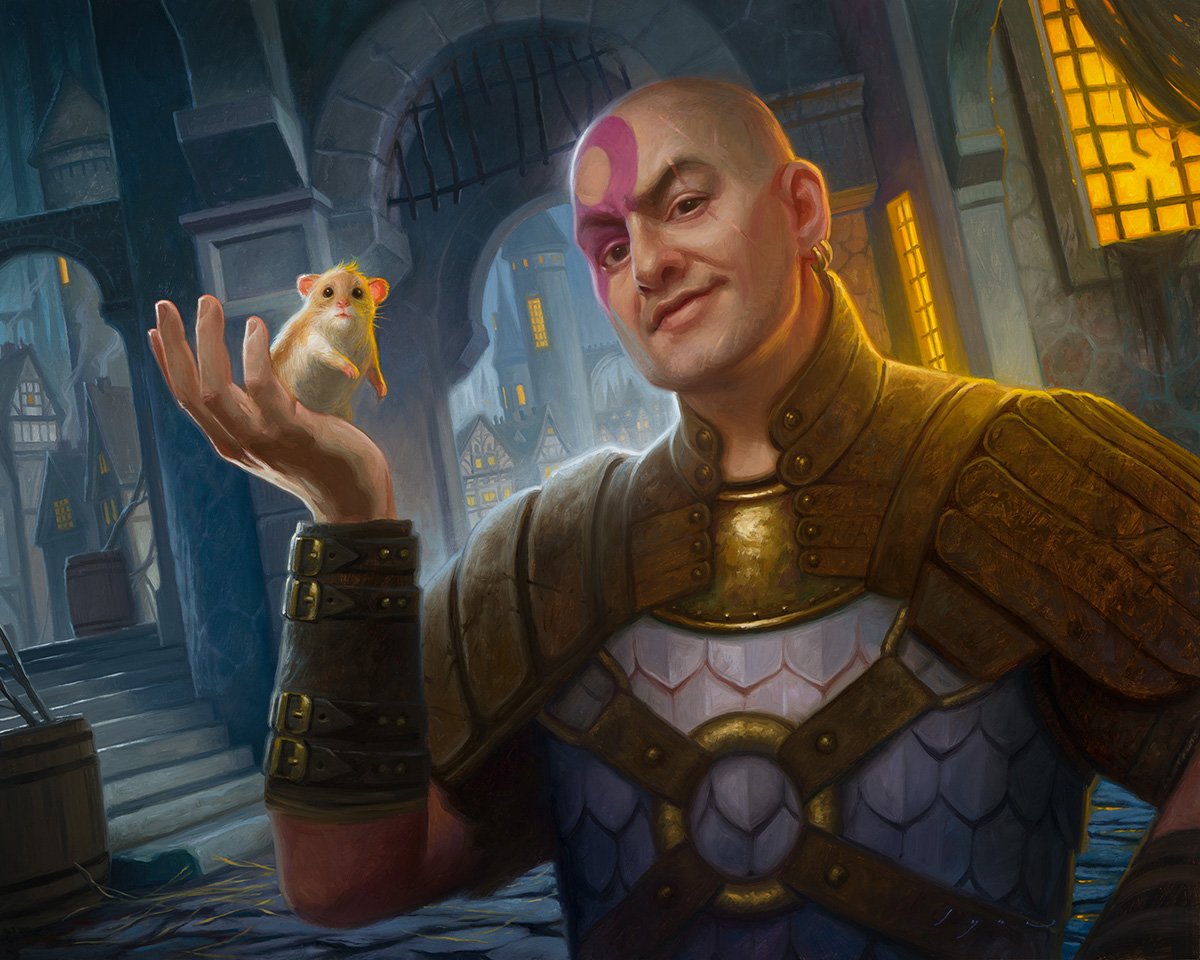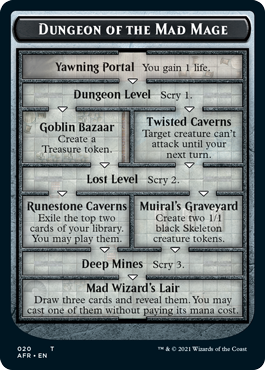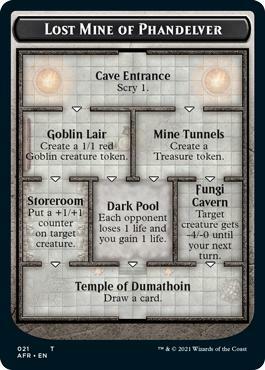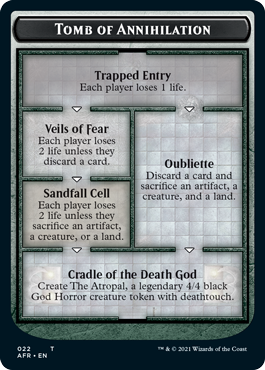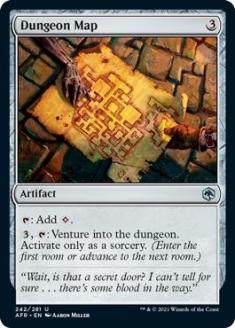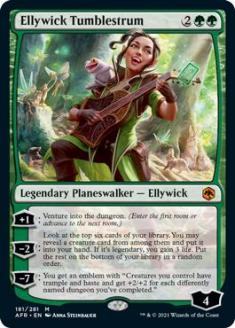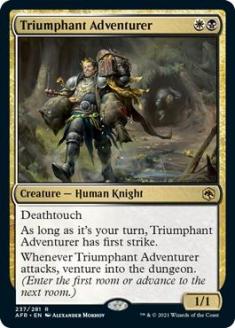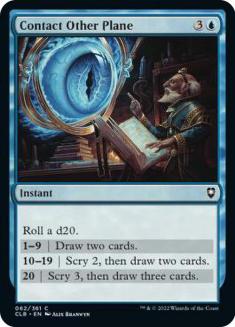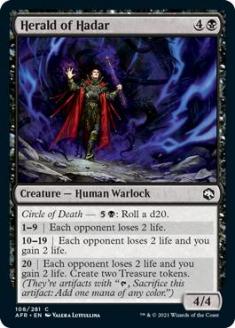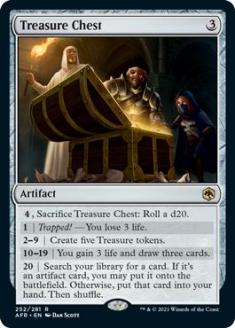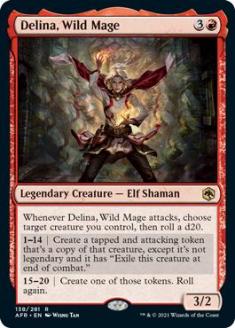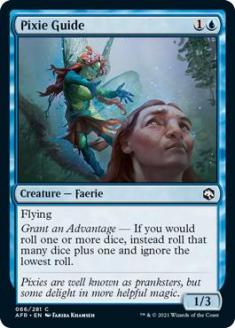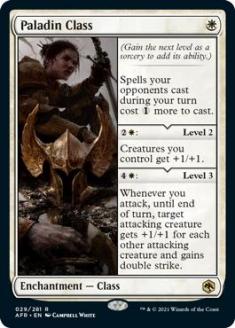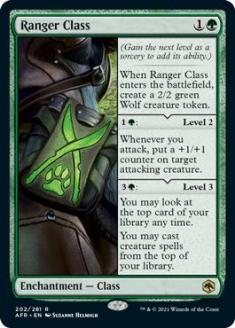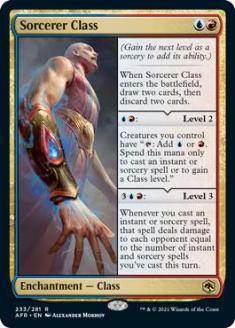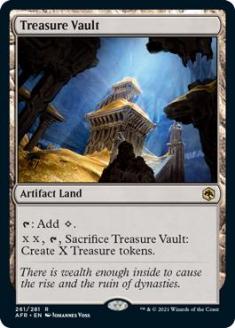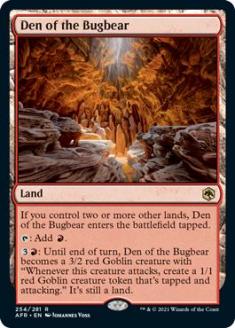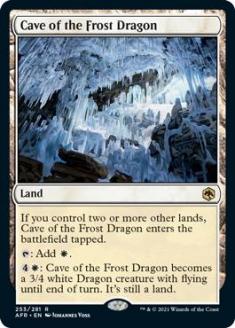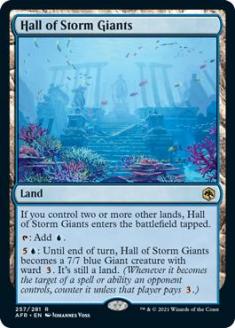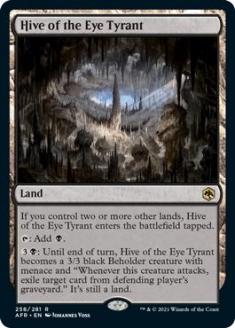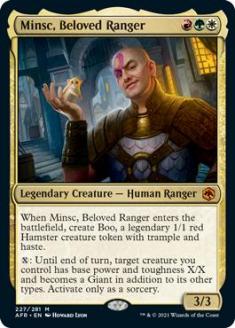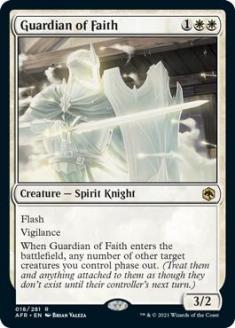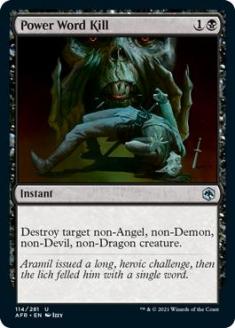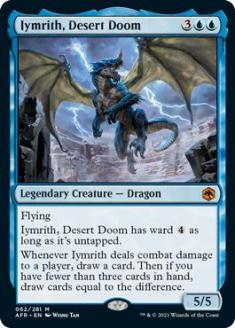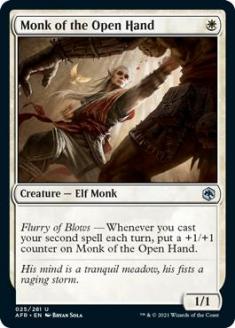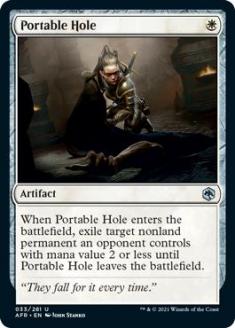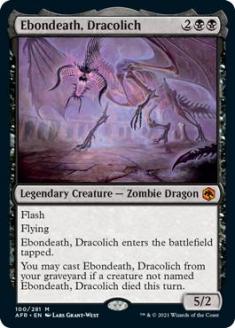Following what feels like the shortest turnaround time between two major Magic releases ever, it’s time to review the expansion with the longest name in Magic history. I hope you’ve picked up everything you need from Modern Horizons 2, because it’s time to talk about Adventures in the Forgotten Realms!
I’ve been looking forward to this set since it was originally announced, and while I’m disappointed to not see heavy-handed support for the party mechanic introduced in Zendikar Rising, there are plenty of high notes in other places. The power level is significantly scaled back relative to most of what is currently Standard legal, but there are some gems on that front all the same. Let’s take a look at the major mechanics of the set and get down to my Top 10 Cube cards!
Dungeons
In my mind, dungeons will be the mechanic that Adventures in the Forgotten Realms will be remembered for. The cards that allow players to venture into the dungeon are generally pretty tame which I believe was a wise move for balance concerns. Even still the experience of playing with them is super fun and evocative and I’m excited to work these into some Cubes.
Because these cards aren’t at an especially high power level I expect the regular Magic Online offerings to eschew the mechanic entirely, and if you do want to incorporate dungeons into one of your Cubes I recommend going heavy on the mechanic so that players have good odds of actually completing one.
Roll a d20
The quintessential Dungeons & Dragons experience, though one that Magic players aren’t generally as keen on. The results tables on the assorted cards that require rolling d20s have a bit of a range regarding how exciting they are, but ultimately it will be easy to avoid playing with or against these cards if you don’t like rolling dice.
If you’re into rolling dice though, there’s a decent spread of playable cards for lower power level Cubes and even a few cards that reference rolling dice to reinforce the experience. Some D&D players really enjoy the idea of breaking the game, and I’m sure that the above combo will show up in a number of Cubes around the world for this very reason.
Class Cards
Finally, we have a new enchantment type to discuss. Classes are sort of like Sagas, except you have to pay mana to level them up and all of their abilities are static abilities that stay in effect as you level the Class. These designs hit all of the right notes flavorfully, and I like a number of the cards for Cube play. None of them are quite powerful enough to just go in any old Cube no questions asked, but I could see all of them fitting into some niche Cube designs.
You won’t find any dungeon or Class cards on my Top 10 list, which is somewhat amusing because these tend to be the cards that I’m more excited to personally play with, they just don’t fit the mold for the classically designed Cubes. Alas. That said, there are plenty of cool cards that work for the classic Cubes and it’s time to get down to the list.
10. Treasure Vault
Treasure Vault is kind of a weird one, but if you’re on the fence about it the tipping point for me is that it’s an artifact land. The more pip intensive your Cube is the less you’ll be able to utilize it, and space for utility lands can be difficult to find, but the opportunity cost here is incredibly low and the potential gain for putting this card in your deck is massive. I’m not above playing a Dark Ritual in my Vintage Cube decks for value with the expectation that sometimes I’ll just need to go fast, and Treasure Vault can serve as a similar mana boost for any color of deck in a pinch that otherwise is just an untapped land.
It will take a bit more than that to justify the inclusion of Treasure Vault in a Cube, but artifact synergies are already aplenty in most high power Cubes and more interactions with Treasure tokens are released all the time. Maybe I’m just looking for more reasons to use all of these Ryan Overturf Treasure tokens, but the opportunity cost of this card is low enough that I’m betting it will play well in a lot of Cubes.
9. Den of the Bugbear
I initially considered listing all five the new creature-lands in one entry given that Cube designs will commonly include every card from cycles like this if they include any card, but I’m both a proponent of asymmetrical cycles and a believer that not all members of this cycle are created equally.
The most important thing that a creature-land can be is efficient, and while members of the new cycle in Adventures in the Forgotten Realms tend to have fairly steep activation costs, they do gain some points back for this by entering the battlefield untapped on the early turns of the game. I’m often critical of the curation of some of the digital Cube offerings for featuring too many red five-drops, and that’s because I’d rather have a mana sink like Den of the Bugbear to give me things to do when I flood than a bunch of stuff like Goldspan Dragon and the intention to get to five mana in every game.
I don’t think that Den of the Bugbear is great because it’s efficient and powerful to activate, I think it’s great because the opportunity cost in aggressive red decks is incredibly low and it offers something to do with your mana when you flood. It also plays well enough in more midrange decks, but I’ll reiterate that actually activating the card ranks much lower on what I like about the card than the fact that it’s an untapped red source.
8. Lair of the Hydra
Everything that I like about Den of the Bugbear is true of Lair of the Hydra, except that green decks will more commonly be interested in activating the card by their nature in the classic Cube environments. A low opportunity cost mana sink that scales into the late-game is awesome, and I’ll spoil the fact that the rest of the cycle did not make my list by saying that I believe Lair of the Hydra to be the best of the lot for Cube play.
I see all five of these cards as solid includes, I just find it easier to justify making space for Lair of the Hydra and Den of the Bugbear in a Cube as well as those two being higher picks in the average draft. When it comes to deckbuilding all five cards will make decks more often than they won’t, but they don’t fit into Cubes as easily and are more difficult to justify drafting as they tend to fit the framework of the average decks of their respective colors worse.
I’d say that Cave of the Frost Dragon is the next best fit by color, though it’s just a bit too inefficient to activate to really move the needle, and Hive of the Eye Tyrant is the next most powerful of the lot but that black aggressive decks just don’t tend to have the best tools in most Cubes. Hall of Storm Giants is the least exciting Cube option by a country mile, but the low opportunity cost does make all five cards worth considering.
7. Minsc, Beloved Ranger
There’s a lot of steep competition when it comes to three-mana creatures in Cube and Naya is generally not a very inviting combination of colors, however Minsc is worth discussing because if you’ve spent much time looking at options for Naya cards the options just aren’t very good. We’ve seen multiple wedge sets with power levels much higher than Shards of Alara, but allied colored three-color have gotten very little support in recent years. Depending on the archetypes that your Cube supports, Minsc is a contender for the most powerful Naya card if you want to push players to play three or more color decks.
Offering two bodies and a mana sink for three mana is solid, but what puts Minsc over is that the X ability can be used as a sacrifice outlet but paying zero. This won’t necessarily come up in a lot of Cubes or in a lot of Naya decks, but it’s something to keep in mind if you have a sacrifice theme and/or Threaten effects in your Cube.
6. Guardian of Faith
I’ve been pretty big on Glorious Protector in any Cube featuring foretell cards since Kaldheim‘s release and have been very impressed to see the card in practice, and Guardian of Faith delivers on some similar axes. Glorious Protector has ended up mattering largely as a giant flash blocker, but Guardian of Faith seems better at executing the role of protection spell.
The ability to phase any number of other creatures means that Guardian of Faith is good against spot removal and sweepers alike, and while it has a body that will generally trade in combat the flash threat more than makes up for this.
Again, three-mana creatures is a fairly congested slot on the mana curve of generally playable Cube cards, but Guardian of Faith is a cut above many of the existing options and gets the nod from me for being good in aggressive white decks and flash decks alike.
5. Power Word Kill
Power Word Kill doesn’t do anything new or flashy, but it does what it does well. I expect that we’ll never get an instant for 1B that just destroys any creature, but the more options that we get for restricted removal spells the closer we get to having approximately that card exist for any given Cube. Power Word Kill will be the best option for a lot of Cubes, a good option for others, and minimally exists as a cool reference.
4. Iymrith, Desert Doom
I would like to introduce you to my friend “strictly different Dragonlord Ojutai”. The comparison between these two cards doesn’t result in one being obviously better, but Iymrith is a mono-color card which makes it easier to fit into most Cubes. Iymrith is among the better options for tap-out control finishers in Cube, and while this won’t be the most powerful strategy in Vintage Cube, this card is definitely playable even there with the right supporting cast.
What I like most about Iymrith is that it’s a blue win condition that makes the game about combat. It doesn’t take that long to close a game, so it might not make the game about a lot of combat steps, but it’s a great blocker and an attacking threat that’s worth protecting with counterspells, which is a line that you’ll often have to cross to get blue players interested in this sort of thing.
3. Monk of the Open Hand
This card was a love at first sight situation for me, and I will be promptly adding it to the Tempo Twobert. Similar to the creature-lands of the set, the conversation here starts with opportunity cost. White aggressive decks want creatures that cost one mana. Check. We’re not done here though. The low mana curve of these decks means that Monk of the Open Hand will often become a 2/2 or even a 3/3 very quickly if it’s not removed. And that’s just when played in a mono-white beatdown deck with a lean curve.
Things get much more interesting once you start introducing cheap cantrips, or even Moxen in the case of Vintage Cube to the mix. If your Cube or the deck you drafted have a high curve you won’t have a great return on this one, but once you start combining it with the cheapest and most powerful cards in Magic’s history it’s actually a very strong threat that scales well into the midgame. It’s not the best topdeck, but decks that are interested in this sort of card don’t have all that many of those anyway.
2. Portable Hole
This is another huge flavor win, and another awesome Cube card. Whether you’re answering a Goblin Guide, a Wrenn and Six, or a Signet, this card is an incredibly efficient and flexible removal spell. It’s one of those cards that gets worse the lower the power level of a Cube is, so you’ll want to be mindful of the fact that higher mana curves will make it much less of a serious contender, but it’s right at home in Vintage Cube and most classic Cube environments.
Being an artifact is a little bit of a bummer as artifact destruction tends to be somewhat easy to come by in a lot of the Cubes that are in the market for Portable Hole, but considering that it’s a removal spell that’s intended on slowing the opponent down this will rarely result in massive blowouts. This is another homerun for the Tempo Twobert, and one that I expect to see in many of the digital offerings.
1. Ebondeath, Dracolich
Finally, my pick for the most impactful Cube card from Adventures in the Forgotten Realms. The more I think about this one, the more I like it. As a baseline, Ebondeath, Dracolich is a huge flying threat with flash with a recursive ability. At four mana it’s priced to fit into controlling and aggressive decks alike, and the fact that you can get it back off of either your opponent’s creatures dying or your own is huge for making it work in either strategy.
Beyond that, being a Zombie and a Dragon opens up the possibility for tribal synergies. Not to mention that just looting it away to get it back when you Doom Blade an opposing threat is a powerful synergy in its own right.
Ebondeath is held back slightly by the fact that it enters the battlefield tapped and thus doesn’t serve as a surprise blocker, but you’d have to weaken it in some other way to allow it to enter untapped because that would have been completely absurd. As is, the card’s abilities combine in powerful ways that fit a variety of strategies, and I expect it to find a home in classic and custom Cubes alike.
I’m generally more excited for the flavor of Adventures in the Forgotten Realms than the power level, but in terms of raw power the set does have a handful of great options for Cube. I’m still miffed about party not being tied in with the set more significantly, but I love the dungeons and the dragons, so I’m sure I’ll find it in my heart to forgive this oversight.

